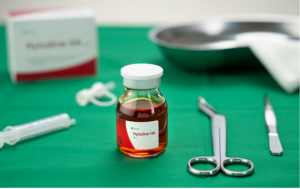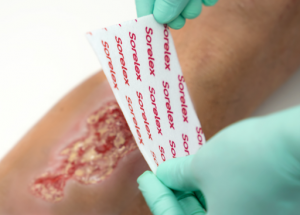
Article: Author: Dr. med. Claus von Schroeder, Facharzt für Allgemeinmedizin, Im Hagen 15, 29549 Bad Bevensen
Hyaluronic acid active substance combinations: The all-purpose weapons in local wound treatment
The medical application spectrum of hyaluronic acid (also: sodium hyaluronate, hyaluronan) is now very broad. It is used in most cases to accelerate healing and has become an indispensable part of the current repertoire of active substances in medicine.
In addition to local wound care, hyaluronic acid is also used very successfully in orthopaedics, ophthalmology and aesthetic medicine. In medicinal products, it usually functions as a carrier medium for other active ingredients. Especially the topical use of products containing hyaluronic acid proves to be very effective in complex, acute and chronic wounds, as they can positively control the complex healing processes.
This is because one of the important properties of hyaluronic acid is to bind a large number of water molecules, thereby ensuring the hydration of the skin and connective tissue. The presence of hyaluronic acid also fulfils an important function in cell differentiation, proliferation and migration throughout tissue regeneration and development.
 Viscous fluid made of hyaluronic acid and iodine complex (Photo: Contipro)
Viscous fluid made of hyaluronic acid and iodine complex (Photo: Contipro)
The evidence is now very clear: in a recently published, prospective, multicentre, randomised, controlled, double-blind study with 168 patients, significantly better healing rates were observed in patients treated with hyaluronic acid compared to the control group.(1) According to various other studies, hyaluronic acid reduces biofilm (2), has an accelerating, positive effect on wound healing and the potential to reduce pain (3) and optimise scar formation (4).
Overall, it ensures higher healing rates and significantly shorter healing times. Hyaluronic acid has been scientifically proven to achieve very good clinical results in the following indications:
- Postoperative wounds (5)
- Military gunshot and shrapnel wounds (6)
- Skin ulcers (7)
- Decubital ulcers (8)
- Diabetic foot syndrome (DFS) (9)
- Negative pressure wound therapy (10)
- Inflammatory tattoo wounds (11)
- Complicated scarring wounds (12)
- Removal site for split skin grafts (13)
- Burn wounds (14).
Furthermore, it is ideal for wound therapy after resections or amputations or for postoperative suture insufficiencies. As hyaluronic acid is a natural, endogenous component, no significant undesirable side effects or counter-reactions have been recorded with oral, topical or injectable application.
The hyaluronic acid-containing products available on the market are available to users in different dosage forms such as granules, cream, membrane, spray, wound dressings or viscous fluid. In the past, native hyaluron was extracted from animal tissue; nowadays it is only produced by microbial fermentation. The associated simplification of the production process as well as the availability in larger quantities are the reasons why modern wound care products with highly concentrated hyaluronic acid are offered at an acceptable price-performance ratio, are increasingly in demand and can be used much more often - also for large-area wounds. For the physician, the price is a not insignificant aspect with regard to cost-conscious prescriptions or compliance with the principle of economic efficiency.
 Adhesive dressing with hyaluronic acid & octenidine (Photo: Contipro)
Adhesive dressing with hyaluronic acid & octenidine (Photo: Contipro)
The latest generation of products that have an additional synergistic active complex in addition to hyaluronic acid are particularly suitable for universal use across all wound phases. An additive antiseptic (e.g. octenidine, iodine) allows these active agent combinations to be used in many ways, much earlier and across wound phases, even in wounds that are still infected. In addition to the advantages already mentioned, the very simple handling and the few necessary change intervals make them very effective and efficient medical products, so that they can justifiably be called an all-purpose weapon in local wound treatment, provided they are adequately indicated.
References
1) Mikosinski J. et al. (2021): Efficacy and Safety of a Hyaluronic Acid-Containing Gauze Pad in the Treatment of Chronic Venous or Mixed-Origin Leg Ulcers: A Prospective, Multicenter, Randomized Controlled Trial. Wounds. 2021 Jun;33(6):147-157 Abstract
2) Romanò C. L. et al. (2017): Hyaluronic Acid and Its Composites as a Local Antimicrobial/Antiadhesive Barrier. J Bone Jt Infect. 2017 Jan 1;2(1):63-72. Abstract
Sobotka L. et al. (2018): The effect of new self-adherent antimicrobial wound dressing on biofilm in comparison with established silver dressing. EWMA 2018 Krakow, Poland 9 – 11 May 2018, EP290. Abstract
3) Hermans J. (2019): The effectiveness of high molecular weight hyaluronic acid for knee osteoarthritis in patients in the working age: a randomised controlled trial. BMC Musculoskeletal Disorders (2019) 20:196 Abstract
Yıldırım S. et al. (2018): Effect of topically applied hyaluronic acid on pain and palatal epithelial wound healing: An examiner-masked, randomized, controlled clinical trial. J Periodontol. 2018 Jan;89(1):36-45. Abstract
4) Alsaedy S. J. et al. (2017): The Efficacy of Topical Hyaluronic Acid Serum in Acne Scar Patients Treated with Fractional CO2 Laser. American Journal of Dermatology and Venereology 2017, 6(2): 17-24. Abstract
Faga A. et al. (2013): Hyaluronic acid three-dimensional scaffold for surgical revision of retracting scars: a human experimental study. Int Wound J. 2013 Jun;10(3):329-35. Abstract
5) Mahedia M. et al. (2016): Clinical Evaluation of Hyaluronic Acid Sponge with Zinc versus Placebo for Scar Reduction after Breast Surgery. Plast Reconstr Surg Glob Open. 2016 Jul 11;4(7):e791 Abstract
Voinchet V. et al. (2006): Efficacy and safety of hyaluronic acid in the management of acute wounds. Am J Clin Dermatol. 2006;7(6):353-7. Abstract
6) Oberreiter M. et al. (2021): The efficacy of hyaluronic acid in combination with an antiseptic - experience from acute military-based wound care. Worldwide Military Medicine ALMANAC 06/2021 Abstract
7) Humbert P. et al. (2013): Efficacy and safety of a gauze pad containing hyaluronic acid in treatment of leg ulcers of venous or mixed origin: a double-blind, randomised, controlled trial. Int Wound J. 2013 Apr;10(2):159-66 Abstract
Motolese A. et al. (2013): Interaction between a regenerative matrix and wound bed in nonhealing ulcers: results with 16 cases. Biomed Res Int. 2013:849321. Abstract
8) Ozgultekin A. et al. 2017: Comparison of hyaluronic acid containing products with wet dressing for severe decubitus ulcers. EP343, EWMA Congress 2017, Amsterdam, The Netherlands, 3–5 May 2017 Abstract
9) Hwang Y. et al. (2016): Hyaluronic Acid Dressing in the Treatment of Diabetic Foot Ulcer: A Prospective, Randomized, Placebo-Controlled, Single-Center Study. Foot & Ankle Orthopaedics 2016; 1:1 Abstract
10) Cetinkaya O.A. et al. (2020): Treatment of hard-to-heal leg ulcers with hyaluronic acid, sodium alginate and negative pressure wound therapy. J Wound Care. 2020 Jul 2;29(7):419-423. Abstract
Sobotka L. et al. (2014): The combination of hyaluronate-iodine complex and negative pressure therapy on non-healing diabetic wounds. EWMA 2014, 14-16 May 2014, Madrid, Spain, P280. Abstract
11) Fioramonti P. et al. (2012): A Successful Collagenase and Hyaluronic Acid Topical Use Combined with Antibiotic Therapy in the Treatment of Ulcerative Lesions Arising on Tattoo. Case Rep Med. 2012; 2012:253492 Abstract
12) Cassuto D., Vinshtok Y. (2020): Treatment of Scar Contracture with Intralesional Jet-Assisted Injection of Hyaluronic acid. J Dermatol Res Ther 2020, 6:094 Abstract
Cassino R., Hussein A. (2019): A topical treatment (gel & cream) to achieve smooth and elastic scars in second and third degree burns. EWMA 2019 Gothenburg, Sweden 5 - 7 June 2019, EP089 Abstract
13) Landi A. et al. (2014): Hyaluronic acid scaffold for skin defects in congenital syndactyly release surgery: a novel technique based on the regenerative model. J Hand Surg Eur Vol. 2014 Nov;39(9):994-1000 Abstract
Onesti M. G. et al. (2014): Long-term in vivo assessment of bioengineered skin substitutes: a clinical study Int Wound J. 2016 Apr;13(2):198-203. Abstract
14) Costagliola M., Agrosì M. (2005): Second-degree burns: a comparative, multicenter, randomized trial of hyaluronic acid plus silver sulfadiazine vs. silver sulfadiazine alone. Curr Med Res Opin. 2005 Aug;21(8):1235-40. Abstract
Kamden A.F. et al. (2021): Assessment of care protocol using hyaluronic acid dressing in Second-Degree skin burns in children. Burns Open (2021) 118-124 Abstract
Voigt J., Driver V.R. (2012): Hyaluronic acid derivatives and their healing effect on burns, epithelial surgical wounds, and chronic wounds: A systematic review and meta‐analysis of randomized controlled trials. Abstract
Date: 09/30/2021











